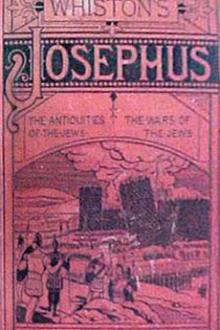The Antiquities of the Jews by Flavius Josephus (top fiction books of all time txt) 📖

- Author: Flavius Josephus
- Performer: 1600964370
Book online «The Antiquities of the Jews by Flavius Josephus (top fiction books of all time txt) 📖». Author Flavius Josephus
8. Now between this candlestick and the table, which, as we said, were within the sanctuary, was the altar of incense, made of wood indeed, but of the same wood of which the foregoing vessels were made, such as was not liable to corruption; it was entirely crusted over with a golden plate. Its breadth on each side was a cubit, but the altitude double. Upon it was a grate of gold, that was extant above the altar, which had a golden crown encompassing it round about, whereto belonged rings and bars, by which the priests carried it when they journeyed. Before this tabernacle there was reared a brazen altar, but it was within made of wood, five cubits by measure on each side, but its height was but three, in like manner adorned with brass plates as bright as gold. It had also a brazen hearth of network; for the ground underneath received the fire from the hearth, because it had no basis to receive it. Hard by this altar lay the basins, and the vials, and the censers, and the caldrons, made of gold; but the other vessels, made for the use of the sacrifices, were all of brass. And such was the construction of the tabernacle; and these were the vessels thereto belonging.
CHAPTER 7. Concerning The Garments Of The Priests, And Of The High Priest.
1. There were peculiar garments appointed for the priests, and for all the rest, which they call Cohanoeoe [-priestly] garments, as also for the high priests, which they call Cahanoeoe Rabbae, and denote the high priest's garments. Such was therefore the habit of the rest. But when the priest approaches the sacrifices, he purifies himself with the purification which the law prescribes; and, in the first place, he puts on that which is called Machanase, which means somewhat that is fast tied. It is a girdle, composed of fine twined linen, and is put about the privy parts, the feet being to be inserted into them in the nature of breeches, but above half of it is cut off, and it ends at the thighs, and is there tied fast.
2. Over this he wore a linen vestment, made of fine flax doubled: it is called Chethone, and denotes linen, for we call linen by the name of Chethone. This vestment reaches down to the feet, and sits close to the body; and has sleeves that are tied fast to the arms: it is girded to the breast a little above the elbows, by a girdle often going round, four fingers broad, but so loosely woven, that you would think it were the skin of a serpent. It is embroidered with flowers of scarlet, and purple, and blue, and fine twined linen, but the warp was nothing but fine linen. The beginning of its circumvolution is at the breast; and when it has gone often round, it is there tied, and hangs loosely there down to the ankles: I mean this, all the time the priest is not about any laborious service, for in this position it appears in the most agreeable manner to the spectators; but when he is obliged to assist at the offering sacrifices, and to do the appointed service, that he may not be hindered in his operations by its motion, he throws it to the left, and bears it on his shoulder. Moses indeed calls this belt Albaneth; but we have learned from the Babylonians to call it Emia, for so it is by them called. This vestment has no loose or hollow parts any where in it, but only a narrow aperture about the neck; and it is tied with certain strings hanging down from the edge over the breast and back, and is fastened above each shoulder: it is called Massabazanes.
3. Upon his head he wears a cap, not brought to a conic form nor encircling the whole head, but still covering more than the half of it, which is called Masnaemphthes; and its make is such that it seems to be a crown, being made of thick swathes, but the contexture is of linen; and it is doubled round many times, and sewed together; besides which, a piece of fine linen covers the whole cap from the upper part, and reaches down to the forehead, and hides the seams of the swathes, which would otherwise appear indecently: this adheres closely upon the solid part of the head, and is thereto so firmly fixed, that it may not fall off during the sacred service about the sacrifices. So we have now shown you what is the habit of the generality of the priests.
4. The high priest is indeed adorned with the same garments that we have described, without abating one; only over these he puts on a vestment of a blue color. This also is a long robe, reaching to his feet, [in our language it is called Meeir,] and is tied round with a girdle, embroidered with the same colors and flowers as the former, with a mixture of gold interwoven. To the bottom of which garment are hung fringes, in color like pomegranates, with golden bells 13 by a curious and beautiful contrivance; so that between two bells hangs a pomegranate, and between two pomegranates a bell. Now this vesture was not composed of two pieces, nor was it sewed together upon the shoulders and the sides, but it was one long vestment so woven as to have an aperture for the neck; not an oblique one, but parted all along the breast and the back. A border also was sewed to it, lest the aperture should look too indecently: it was also parted where the hands were to come out.
5. Besides these, the high priest put on a third garment, which was called the Ephod, which resembles the Epomis of the Greeks. Its make was after this manner: it was woven to the depth of a cubit, of several colors, with gold intermixed, and embroidered, but it left the middle of the breast uncovered: it was made with sleeves also; nor did it appear to be at all differently made from a short coat. But in the void place of this garment there was inserted a piece of the bigness of a span, embroidered with gold, and the other colors of the ephod, and was called Essen, [the breastplate,] which in the Greek language signifies the Oracle. This piece exactly filled up the void space in the ephod. It was united to it by golden rings at every corner, the like rings being annexed to the ephod, and a blue riband was made use of to tie them together by those rings; and that the space between the rings might not appear empty, they contrived to fill it up with stitches of blue ribands. There were also two sardonyxes upon the ephod, at the shoulders, to fasten it in the nature of buttons, having each end running to the sardonyxes of gold, that they might be buttoned by them. On these were engraven the names of the sons of Jacob, in our own country letters, and in our own tongue, six on each of the stones, on either side; and the elder sons' names were on the right shoulder. Twelve stones also there were upon the breast-plate, extraordinary in largeness and beauty; and they were an ornament not to be purchased by men, because of their immense value. These stones, however, stood in three rows, by four in a row, and were inserted into the breastplate itself, and they were set in ouches of gold, that were themselves inserted in the breastplate, and were so made that they might not fall out. Now the first three stones were a sardonyx, a topaz, and an emerald. The second row contained a carbuncle, a jasper, and a sapphire. The first of the third row was a ligure, then an amethyst, and the third an agate, being the ninth of the whole number. The first of the fourth row was a chrysolite, the next was an onyx, and then a beryl, which was the last of all. Now the names of all those sons of Jacob were engraven in these stones, whom we esteem the heads of our tribes, each stone having the honor of a name, in the order according to which they were born. And whereas the rings were too weak of themselves to bear the weight of the stones, they made two other rings of a larger size, at the edge of that part of the breastplate which reached to the neck, and inserted into the very texture of the breastplate, to receive chains finely wrought, which connected them with golden bands to the tops of the shoulders, whose extremity turned backwards, and went into the ring, on the prominent back part of the ephod; and this was for the security of the breastplate, that it might not fall out of its place. There was also a girdle sewed to the breastplate, which was of the forementioned colors, with gold intermixed, which, when it had gone once round, was tied again upon the seam, and hung down. There were also golden loops that admitted its fringes at each extremity of the girdle, and included them entirely.
6. The high priest's mitre was the same that we described before, and was wrought like that of all the other priests; above which there was another, with swathes of blue embroidered, and round it was a golden crown polished, of three rows, one above another; out of which arose a cup of gold, which resembled the herb which we call Saccharus; but those Greeks that are skillful in botany call it Hyoscyamus. Now, lest any one that has seen this herb, but has not been taught its name, and is unacquainted with its nature, or, having known its name, knows not the herb when he sees it, I shall give such as these are a description of it. This herb is oftentimes in tallness above three spans, but its root is like that of a turnip [for he that should compare it thereto would not be mistaken]; but its leaves are like the leaves of mint. Out of its branches it sends out a calyx, cleaving to the branch; and a coat encompasses it, which it naturally puts off when it is changing, in order to produce its fruit. This calyx is of the bigness of the bone of the little finger, but in the compass of its aperture is like a cup. This I will further describe, for the use of those that are unacquainted with it. Suppose a sphere be divided into two parts, round at the bottom, but having another segment that grows up to a circumference from that bottom; suppose it become narrower by degrees, and that the cavity of that part grow decently smaller, and then gradually grow wider again at the brim, such as we see in the navel of a pomegranate, with its notches. And indeed such a coat grows over this plant as renders it a hemisphere, and that, as one may say, turned accurately in a lathe, and having its notches extant above it, which, as I said,





Comments (0)